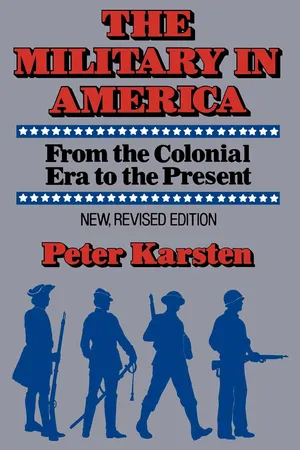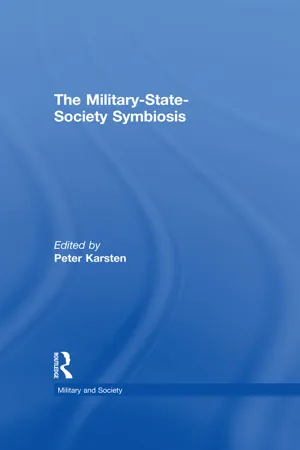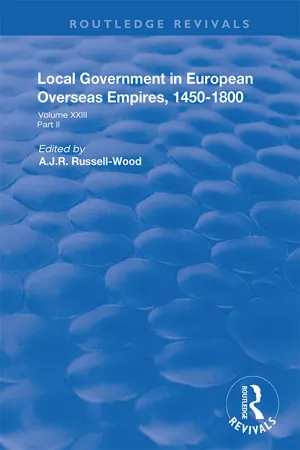History
Colonial Militia
Colonial militia refers to a military force composed of ordinary citizens who were trained to defend their communities during the colonial period in America. These militias played a crucial role in protecting the colonies from external threats and were often called upon to support regular troops during times of conflict. The colonial militia system laid the groundwork for the development of the American military tradition.
Written by Perlego with AI-assistance
Related key terms
4 Key excerpts on "Colonial Militia"
- eBook - ePub
- Peter M. Karsten(Author)
- 1986(Publication Date)
- Free Press(Publisher)
The Colonial EraPassage contains an image
1A New Look at Colonial Militia JOHN W. SHYSome have argued that military systems are major forces, shaping the political and social order; others see them as essentially reflective of the societies they serve. The history of the several compulsory and voluntary militia and expeditionary military organizations of the colonial era provide evidence relevant to these questions.* John Shy’s “new look at Colonial Militia,” a comparison of the military systems of different colonies throughout the seventeenth and eighteenth centuries, certainly suggests a diversity of experience, reflecting differing colonial social and economic settings and political purposes.THE SUBJECT OF THE MILITIA has produced some passionate writing by American publicists, soldiers, and historians. Defenders of the militia—those who believe that a universal military obligation is the proper way to defend a society—are fond of stressing that only when free men must themselves fight to protect their liberty are they likely to remain free. The Colonial Militia, in particular, represents the happy uniqueness of America, where Englishmen in the seventeenth century revived this military relic of the middle ages just as in Europe it was sinking beneath the superiority of the politically dangerous mercenary army on the battlefield. Critics of the militia—many of them professional soldiers—point a different moral, one that rests on the apparent inefficiency of militia in combat, and on the way that the myth of defense by militia led again and again to tragic unpreparedness for war.SOURCE : John W. Shy. “A New Look at Colonial Militia,” William and Mary Quarterly , 20 (April 1963): 175-185. Copyright 1963 by John W. Shy. Reprinted by permission.EDITOR’S NOTE - eBook - ePub
- Peter Karsten(Author)
- 2013(Publication Date)
- Routledge(Publisher)
A New Look at Colonial MilitiaJohn W. Shy*T HE subject of the militia has produced some passionate writing by American publicists, soldiers, and historians. Defenders of the militia—those who believe that a universal military obligation is the proper way to defend a society—are fond of stressing that only when free men must themselves fight to protect their liberty are they likely to remain free. The Colonial Militia, in particular, represents the happy uniqueness of America, where Englishmen in the seventeenth century revived this military relic of the middle ages just as in Europe it was sinking beneath the superiority of the politically dangerous mercenary army on the battlefield. Critics of the militia—many of them professional soldiers—point a different moral, one that rests on the apparent inefficiency of militia in combat, and on the way that the myth of defense by militia led again and again to tragic unpreparedness for war.There is one point, however, where critics and defenders appear to agree: it is on the assumption that the militia, especially the Colonial Militia, is a fairly static institution; once its simple theory of organization has been described, there seems little need to watch it as closely for signs of deviation and change as one would watch, say, political institutions. Historians have tended to go along with this assumption, as they have generally accepted the major tenets of both defenders and critics; in short, the militia is usually regarded as both politically healthy and militarily inefficient, but in any case relatively uncomplicated.1 - eBook - ePub
- A.J.R. Russell-Wood(Author)
- 2018(Publication Date)
- Routledge(Publisher)
Barbados conformed to this general pattern and, as the years progressed, on the island, as elsewhere, legislative actions codified and formalized the militia structure and the qualifications of those who were expected to serve and function in leadership positions. Shortly after colonization in 1627 Barbados established limited military fortifications and an apparently rudimentary militia organization, and by the midto-late 1630s, if not earlier, large planters held military titles and were the militia's chief officers. 4 During the 1640s, the militia was reorganized; several acts pertaining to military defences were passed, a militia muster role existed, and militia training was apparently occurring with some regularity. By the late 1640s, a formally organized militia, codified in law and numbering in the thousands, was an important feature of Barbadian society as, indeed, were the militias in England's other New World colonies. In 1650 and 1651 additional legislation constructed an apparently more formal militia structure than had hitherto existed, and further reorganization took place in 1652 and again in 1656. 5 Subsequent years saw additional structural modifications, but as a societal institution the militia was to persist for the duration of the slave period and into post-emancipation times. Viewed over the span of Barbados's pre-emancipation history, the evidence clearly shows that, with varying degrees of intensity (depending on England's/Britain's international relations at any given period), the pre-eminent colonial interest in the militia's organization and the maintenance of its strength (as well as the strength and state of the island's fortifications) derived from a concern over external attack by foreign forces, particularly the French - eBook - ePub
A Short, Offhand, Killing Affair
Soldiers and Social Conflict during the Mexican-American War
- Paul Foos(Author)
- 2003(Publication Date)
- The University of North Carolina Press(Publisher)
Thus it was the persistence of the militia ethic rather than its demise that is striking. The actual usefulness of militias as keepers of order or as defenders against invasion proved to be marginal. Working people rebelled against militia service when it became an instrument of compulsion, with rules and leadership imposed by state government. The opponents of universal militia service objected to appointed officers, and exemptions for the well-to-do, but military service was not necessarily objectionable to them when they could choose their own group affiliations and their own leaders —even if those leaders were from an elite economic or political background.In the 1820s and 1830s poor and middling folk in Philadelphia, New York, Albany, New Haven, and other cities showed blatant contempt for compulsory militia service. The notorious Colonel Pluck was a half-witted stable hand elevated to leadership of a Philadelphia militia battalion. Militia conscripts paraded him through the streets ridiculously mounted and uniformed, followed by militiamen likewise out of uniform and carrying cornstalks and broomsticks. This was a deliberate affront to the system of appointed officers and preferences granted to wealthy members of volunteer companies.In the 1820s and 1830s Pennsylvania allowed paid deferments for those who could afford it, while laborers, mechanics, and artisans gave up their time and supplied their own weapons and uniforms. Those who could afford to, formed volunteer militia companies composed of their social equals, and it was out of the ranks of the latter that the smartly caparisoned regimental officers were chosen. Workingmen criticized the officers and the volunteer companies as unrepublican in their finery and because of the preferential political connections through which they obtained their commissions.23But at the local, or company, level the social and political function of the militia had a strong appeal and the voluntarist impulse was alive and well, manifesting itself in political clubs and volunteer fire companies. Volunteer organization was not only for the elite; it allowed people at all social levels to assert group identity.24 Fire companies became even more popular than militias in the 1830s and 1840s as egalitarian expressions of small-group democracy, combining solidarity and an exemplary heroism. Like the militias, fire companies were often socioeconomically mixed, encompassing merchants, industrialists, tradesmen, and artisans. But they manifested strongly egalitarian ideas and practices: a manly solidarity in the face of danger and arduous labor; social cohesion within a small group; and a willingness to use violence against groups they perceived as a danger to the community, such as immigrants or lawbreakers. Also, like the independent militias, the volunteer fire company was swept away by large-scale politics and economic rationalism in the decades before the Civil War.25
Learn about this page
Index pages curate the most relevant extracts from our library of academic textbooks. They’ve been created using an in-house natural language model (NLM), each adding context and meaning to key research topics.



